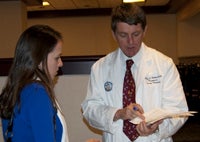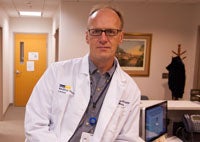Improving Care Through a Medical Home

Posted in GUMC Stories
 Many American families require a rolodex to take care of their healthcare needs: a pediatrician for the youngsters, an internist and OB-GYN for the parents, and, later, inevitably, a squad of specialists. They make their own appointments, and worry about what they may be missing.
Many American families require a rolodex to take care of their healthcare needs: a pediatrician for the youngsters, an internist and OB-GYN for the parents, and, later, inevitably, a squad of specialists. They make their own appointments, and worry about what they may be missing.
It’s a far cry from the idealized Norman Rockwell vision of the hometown “doc” who knows his patients inside and out and takes care of them, as much as possible, from cradle to grave.
But medicine is now taking a step back to that gracious past while leaping forward with the use of technology. Medical “homes” are popping up around the United States. They all share common themes that include the use of advanced information technology to track and support improved care quality, efforts to enhance care coordination within an integrated health network, and a focus on enhancing the patient experience. In addition, with family physicians, the entire family will have the opportunity to have care from a single provider.
Georgetown University, in collaboration with MedStar Health, is pioneering such an approach in the Washington, D.C. area. The MedStar Health Center-Family Medicine practice at Spring Valley opened last August, and is filling up rapidly. It’s revolutionary for a number of reasons, not least because the new medical home represents the first time faculty from Department of Family Medicine at Georgetown University School of Medicine have the chance to practice together as a team.
 The physicians have long been seeing primary care patients at many different health centers around the area, but they have never worked together in their own healthcare entity, says James Welsh, M.D., chairman of the Department of Family Medicine.
The physicians have long been seeing primary care patients at many different health centers around the area, but they have never worked together in their own healthcare entity, says James Welsh, M.D., chairman of the Department of Family Medicine.
“We are excited to be doing this,” he says. “The reality is that there are a lot of patients in D.C. who see multiple physicians but don’t have the sense that anybody is really in charge of their health care. And that’s really the role that we’ve always traditionally done in family medicine.
“But I think the medical home takes family care to a different level,” Welsh says. “We can get to know our patients well and provide coordinated comprehensive care for them using tools that we’ve never really had before.”
Continuous healing relationship
The concept of a patient-centered medical home evolved in the 1960s from pediatricians who needed a way to coordinate care of seriously ill children, says Vince WinklerPrins, M.D., who directs medical student education as the family medicine clerkship director and is also an expert in reform of health policy.
The concept has lately been broadened to encapsulate elements of evidence-based medicine, such as the measurement of the quality of care being delivered, as well as reorganization of practices to incorporate health information technology, he says.
But the key change is the renewed focus on the health of a family unit, however organized, WinklerPrins says. “A medical home is a great place for people to bring in their entire extended family for care. We learn about our patients by viewing them in the contexts of those with whom they associate — who they live with, who their children are, who their parents are — and then seeing these family members as patients too.
“This perspective has really been underemphasized in health care, but it gives us the power to take care of people in the most effective and comprehensive way possible,” he says.
Six faculty attending physicians are practicing at the MedStar Health Center-Family Medicine at Spring Valley. Most are there part time, between teaching and research duties. This is also a teaching center in an outpatient location with medical students and medical education core to their work. The facility offers care during evening hours and on Saturdays, and early feedback shows that patients are very satisfied with the comprehensive care, Welsh says.
If patients need to see specialists, their doctor will refer them to physicians within the MedStar Health system, including members of the Georgetown Physicians Group, a process that has been made seamless through use of electronic referral systems and health records. “We keep track of what happens,” Welsh says. “We make sure that the patient does indeed go to see that specialist or get a needed test, and that we get a report back.”
Electronic health records allow them to think proactively about preventive services that may be needed for a given patient. “For example, I can find out very quickly how well diabetes is being controlled in my patients,” says WinklerPrins. “I can then engage these folks, ask them to come in, and perhaps meet with a registered dietician or connect them with other people who can help.
“When you treat the total patient, you focus not only on the disease that the patient wants to work on but also on the entire picture of that person’s health,” he says.
Doctors want change too
The family practice is seeking certification as a patient centered medical home by the National Committee on Quality Assurance and is on its way through the process, says Welsh.
But in order for the practice to work as effectively as possible, the current healthcare reimbursement system has to change, he says. “We’re moving forward with an enhanced model of care but still living in a 1990’s model of reimbursement.”
The current fee-for-service structure does not support the enhanced services that the patient centered medical home seeks to provide.
Despite this, “the majority of physicians would value an opportunity to work in a more integrated way to enhance the quality of the care provided to the patients they serve,” WinklerPrins says.
Things are moving in the right direction, Welsh says. “For the first time, we have a place where we can all practice and have meaningful and continuous relationships with our patients.
MedStar Health’s Executive Vice President Eric R. Wagner says that in the next five years, the system’s entire primary care network throughout Maryland and the District of Columbia will adopt a model similar to the new Spring Valley practice.
“Market research told us there was a great need for a medical practice built around patients. Every aspect of this practice was driven by patient input and patient satisfaction is very high,” he says. “We’re excited about our collaboration with Dr. Welsh and the Georgetown Family Medicine Department.”
“It’s a huge leap forward,” Welsh acknowledges, “back to the way medicine used to be practiced but with all the technological bells and whistles.”
By Renee Twombly, GUMC Communications
(Published February 1, 2012)
